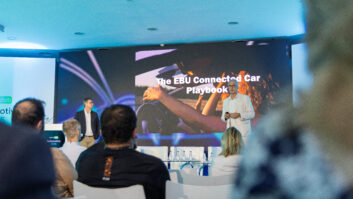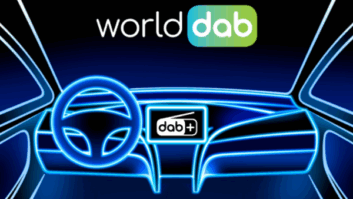Want to accurately measure which radio stations drivers are listening to? Simply query their Wi-Fi enabled, connected in-car radio receivers on a minute-by-minute basis, and collect that data for later analysis.
There’s no guesswork involved. Today’s connected car radios can record which stations the driver tuned to and for how long; and report this information to researchers via the car’s internet-connected Wi-Fi system.
The resulting analyzed data would be a precise representation of who was listening to what, within whatever geographic radio market a measurement agency is interested in. Theoretically, if the drivers being surveyed also volunteered their ages and other demographic information to the researchers, the results could provide broadcasters and advertisers with truly meaningful audience insights.
General Motors recently tested this approach (without asking for ages and other personal information) by conducting what it called a “proof of concept” in-car radio measurement study in Chicago and Los Angeles. Around 90,000 GM drivers agreed to have their in-car listening habits monitored between November 2017 and January 2018, so that the automaker could test the validity of in-car audience measurement.
The study’s results were subsequently presented by GM Director of Global Digital Transformation Saejin Park at the Association of National Advertisers’ 2018 Data & Measurement Conference. It was held in Orlando, Fla. in September.
“The focus of the presentation was to show how connected vehicle data can be used to help develop more robust ways to measure radio listenership,” said Jim Cain, GM’s senior manager of sales & executive communications. “Current ratings system that rely on diaries or Personal People Meters have many limitations, including small sample sizes. The idea here is that the millions of connected radios generate data that could allow for more radio markets to be measured very accurately.
“For example, one can measure which station was tuned in, when and how long the driver listened and at what volume,” Cain said. “You also could generate insights that would allow for more relevant/targeted content to be delivered through the medium.”


This last point is of particular interest to GM. The company wanted to see if there is a correlation between consumer listening habits and their buying preferences. For instance, which restaurants does a driver who listens to country music format stations prefer, and is there a difference between the places they eat and those chosen by rock station listeners?
If there is, could such data help advertisers better target their pitches to the most receptive consumers? If so, GM could make money collecting audience data for radio stations, adding another revenue stream to its portfolio.
As for those who worry that GM violated the privacy of the 90,000-plus drivers who took part in the survey, by sharing the results of their listening behaviors?
“Customers who use connected services must first opt in by accepting our terms of use and privacy statement describing how we use connected vehicle data,” replied Cain. “For customers who opt in, the data is aggregated and anonymized and would represent the results over a very large sample size and would not include any personally identifiable information.”
WHAT GM LEARNED
According to an online news report prepared by WARC (www.warc.com), a global consultancy that sells advertising best practices advice, Saejin Park shared the following results with her Association of National Advertisers audience. (Radio World verified the accuracy of the report with GM prior to publication; Park herself was not made available for an interview. WARC shared its full subscription report with the Detroit Free Press, which also cited quotations from Park’s presentation, again verified with GM.)
According to Park, the brands and models that GM owners drive appear to be correlated with their listening preferences. For instance, someone who drives a Cadillac Escalade “might be more likely to listen to 101.5. But someone else … driving a GMC Yukon — same-sized vehicle, but a different brand — would be more likely to listen to 101.1.”
“Even in this world of crude radio-station entertainment, different types of people listen to different stations in different kinds of vehicles,” she reportedly told the ANA audience. “And you can start testing [that] by sending them different kinds of advertising to see some kind of behavior in the [listening] patterns.”
Being able to correlate drivers’ buying preferences with their radio listening choices could make it easier for advertisers to create more effective targeted commercials. For instance, GM noticed that one driver listened to a country and western station, and frequented a Tim Horton’s coffee shop regularly. Could another restaurant such as McDonald’s reach this listener by running coffee-targeted ads on the same radio station?
On a larger scale, GM could use this data to drive purchases through its in-car Marketplace, using the car’s LCD display to promote deals at participating GM advertisers such as Applebee’s, Dunkin’ Donuts and ExxonMobil. It could also sell this data directly to advertising agencies and third-party advertisers.
“We’re looking for ways to use these kinds of datasets,” said Park at the ANA conference. “It’s a complicated, complex problem, and I don’t know what the answer is. But GM is really interested in finding out what the potential path could be.”
THE ROAD AHEAD
All of this, of course, could have implications for the existing radio ratings infrastructure; Nielsen surely is paying close attention. But GM professes to having no immediate plans to go any further with in-car radio audience measurement.
“Our proof of concept has generated interest in the advertising and broadcast communities,” said Cain. “But we don’t have any new projects to announce at this time. [And] if we were to license data, it would be for very specific use cases that would be thoroughly vetted by us.”
This said, GM has thrown down a gauntlet, by showing how useful in-car radio listening measurement could be as an audience detection and advertising refinement tool. What remains to be seen is whether or not someone picks up this gauntlet, and develops in-car listening measurement as a viable tool.







